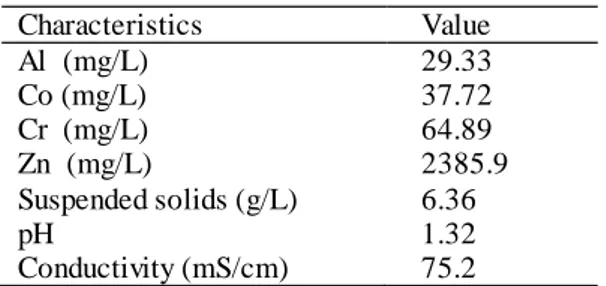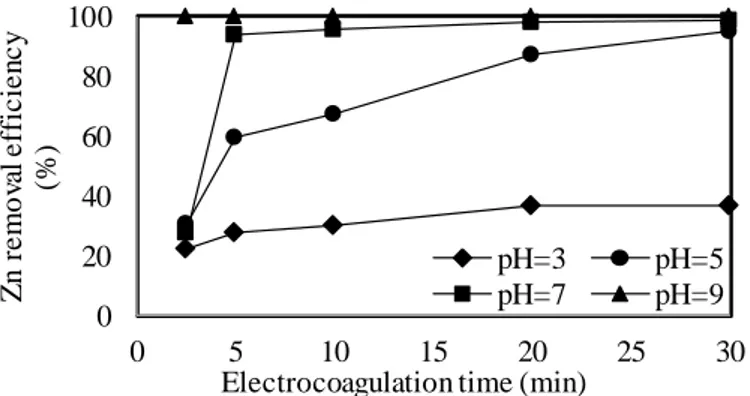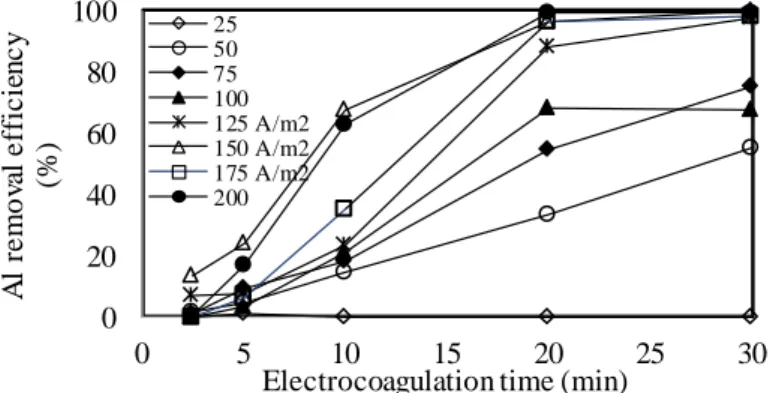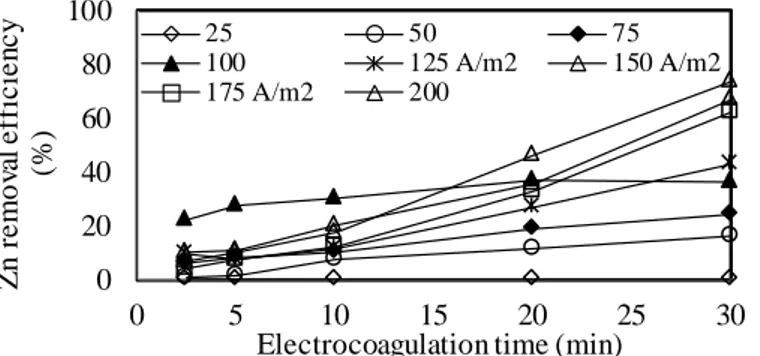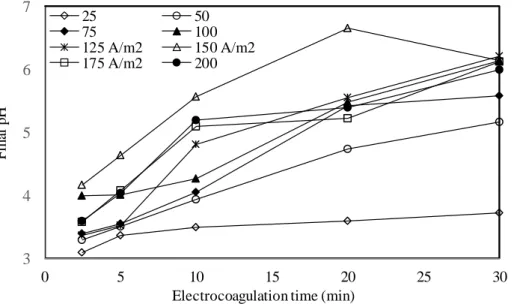RESEARCH ARTICLE
225
THE EFFECT OF PH AND CURRENT DENSITY IN THE REMOVAL OF ALUMINUM COBALT, CHROMIUM, AND ZINC FROM METAL PROCESSING WASTEWATER BY
ELECTROCOAGULATION METHOD Nevzat BEYAZIT1,* and Banu TÜRK2
1 Ondokuz Mayıs University, Faculty of Engineering, Department of Enviromental Engineering, Samsun,
nbeyazit@omu.edu.tr, ORCID: 0000-0002-8396-5996
2 Ondokuz Mayıs University, Faculty of Engineering, Department of Enviromental Engineering, Samsun,
turkbanu61@gmail.com, ORCID: 0000-0002-7809-3468
Recieved Date:29.10.2020 Accepted Date: 16.12.2020
ABSTRACT
In this study, the effects of initial pH (3, 5, 7, 9) and current density (25, 50, 75, 100, 125, 150, 175, 200 A/m2) on the removal of Al3+, Co2+, Cr6+ and Zn2+ions from metal processing wastewater by electrocoagulation method were examined. Iron and stainless steel electrodes were used as anode and cathode materials. All of the removal efficiencies were insignificant at the initial pH value of 1.32 . As the initial pH values were increased the removal efficiencies increased in all stages of the experiments. With increasing the pH from 3 to 9, removal efficiencies increased from 67.4% to 99.2% for Al, from 18.1% to 99.7% for Co, and from 36.6% to 99.9% for Zn, while removal efficiencies for Cr were over 99% for each pH. Although the inital concentration of Co was relatively low, it was only removed with over 99% efficiency at long electrocoagulation times or at relatively high final pH values. A similar trend was determined for Zn, but this case was explained by a relatively high concentration of Zn. While the maximum removal efficiency was achieved with a current density of 50 A/m2 for Cr, the efficiency increases were more obvious with increasing current density for Al, Co, and Zn. Keywords: Electrocoagulation, pH, Current Density, Metal Processing
1. INTRODUCTION
Most of the metals such as aluminium, cobalt, chromium, and zinc are toxic or carcinogenic and cause toxic effects. Therefore, it is very important to treat metal-containing wastewaters before discharging into receiving environments.The most used heavy metal removal from wastewaters containing metal ions is precipitation with Ca(OH)2, NaOH, and coagulation with FeSO4 or Al2(SO4)3 compounds [1,2,3,4]. Other technologies include chemical precipitation [5], ion-exchange [6], adsorption [7], biosorption [8] membrane filtration [9], coagulation-flocculation [3], flotation [10] and electrocoagulation (EC) [4,11]. Although chemical precipitation of these methods seems appropriate in terms of applicability, it produces a large amount of sludge [12]. The electrocoagulation method is more economical because of low sludge production [11]. EC is a method that can be easily applied without the need for additional chemicals [13,14,15]. The fact that the sludge flocs formed in this method are relatively large, contain less bound water, and are stable, allowing them to be separated easily by filtration [16-18]. Also, it is known that sludge flocs formed in this method are effective in
Beyazıt N. and Türk B., Journal of Scientific Reports-A, Number 45, 225-235, December 2020.
226
removing the smallest colloidal particles. In most of the studies reported in the literature [11,19-24] except that of Heidmann and Calmano [25], the metal concentrations in their wastewaters were relatively low.
Unlike these studies, the wastewater used in the present study contained Zn in high concentrations. In this context, this paper deals with the mechanisms influencing heavy metal removal performance from original real wastewater by electrocoagulation method. It was studied the effects of initial pH and current density on the removal of Al, Co, Cr, and Zn.
2. MATERIALS AND METHODS 2.1. Wastewater characterization
The wastewater samples were collected from an aluminum-zinc metal processing facility located in Sinop city. In this facility, using the alloy obtained by adding aluminum and copper to pure zinc, the production of the door handle, window handle, decorative aluminum products (Furniture and Table Leg, etc.), hinges, fittings, and auxiliary accessories are carried out. Using the electro galvanizing method, the materials produced are subjected to zinc and chromate coating to prevent corrosion that may occur on product surfaces. The annual consumption of aluminum and its alloys are 7891 tons. The amount of wastewater consisting of metal coating effluents is 83 m3 per day. Wastewater samples were collected from this facility and filtered through a coarse filter to separate the soluble solids before use in experiments. The composition of the wastewater is presented in Table 1. It is pointed out that very high zinc concentration in wastewater characterization was due to zinc solutions used extensively in the facility.
Table 1. Composition of the wastewater.
2.2. Experimental apparatus and procedure
The experiments were carried out in an 8.95 x 8.95 x 8.85 cm (width x length x depth) plexiglass reactor. EC experiments were evaluated for 30 minutes of electrolysis time. As the anode and the cathode, iron and stainless steel electrodes of rectangular shape with 4.5 cm width x 5.7 cm length x 0.3 cm thickness were used in all experiments. The EC reactor, which contained 3 anodes and 3 cathodes connected in monopolar parallel with a total active anode surface area of 148.60 cm2, was connected to a direct current power source (GW GPC-3060D DC Power Supply 0-30 V, 0-6 A), which was operated at a galvanostatic mode. In other words, even if the resistance against the current changed, constant current flow was provided in all conditions. pH and conductivity measurements were made with a Thermo Scientific Orion 4-Star Plus Portable pH/Conductivity Meter. The experiments were carried out with 600 mL of wastewater at 200 rpm mixing speed. The metal oxide layers formed on the anode and cathode surfaces during the experiments were cleaned with
Characteristics Value Al (mg/L) 29.33 Co (mg/L) 37.72 Cr (mg/L) 64.89 Zn (mg/L) 2385.9 Suspended solids (g/L) 6.36 pH 1.32 Conductivity (mS/cm) 75.2
Beyazıt N. and Türk B., Journal of Scientific Reports-A, Number 45, 225-235, December 2020.
227
hydrochloric acid (37% HCl) and dried at 110 °C for 30 minutes. Metal analysis in treated wastewater samples taken at 5 mL periodically was performed using inductively coupled plasma optical emission spectroscopy (Perkin ELMER ICP-OES, Optima 7000 DV) according to the standard methods for the examination of water and wastewater [26]. Wastewater was used in all experiments in original conductivity (75.2 mS/cm) to prevent current resistance, which was enough for transferring the electrons from the anode, without the addition of electrolyte was made [4]. Although the effects of experimental parameters were determined without optimization, at the end of the experimental studies, by using the optimum experimental values obtained for each experimental stage, the maximum achievable removal efficiencies were determined with electrical energy consumptions.
2.2.1. Calculations
In the EC reactor, the anode and the electrical energy consumption were calculated according to Faraday’s law [27] and (Eq. 1) to the mathematical expression [28] given in Eq. (2), respectively. m =I.t.M
z.F.V (1)
where m is the amount of the dissolved anode material (g), I is the current (A), t is the electrolysis time (s), M is the molar mass of aluminum and iron (g/mol), z is the number of electron transfer, F is the Faraday's constant (96,485.34 As/mol), and V is the volume of wastewater (m3)
E =I.t.UV (2)
Where E is the electrical energy consumption, I is the current (A), t is the electrolysis time (s), U is a voltage (v), V is the volume of wastewater (m3).
3. RESULTS AND DISCUSSION 3.1. Effect of pH
pH is a very effective operating parameter in removing pollutants in EC systems [22]. The initial pH values ranging from 1.32 (original) to 9 were studied under constant experimental conditions (current density: 100 A/m2, stirring speed: 200 rpm, inter-electrode gap: 0.6 cm) as shown in Fig (1-4). After 30 minutes of EC, the removal efficiencies of Al, Co, Cr, and Zn were insignificant at an initial pH of 1.32. Fig. 5 shows the variations in final pH values concerning their initial values.
Beyazıt N. and Türk B., Journal of Scientific Reports-A, Number 45, 225-235, December 2020.
228
Figure 1. Effect of initial pH on Al removal efficiency.
Figure 2. Effect of initial pH on Co removal efficiency.
Figure 3. Effect of initial pH on Cr removal efficiency. 0 50 100 0 5 10 15 20 25 30 C o r e m o va l e ff ic ie n c y ( % )
Electrocoagulation time (min)
pH=3 pH=5 pH=7 pH=9 0 20 40 60 80 100 0 5 10 15 20 25 30 A l re m o va l e ff ic ie n c y (% )
Electrocoagulation time (min)
pH=3 pH=5 pH=7 pH=9 0 20 40 60 80 100 0 5 10 15 20 25 30 C r re m o va l e ff ic ie n c y ( % )
Electrocoagulation time (min)
pH=3 pH=5
Beyazıt N. and Türk B., Journal of Scientific Reports-A, Number 45, 225-235, December 2020.
229
Figure 4. Effect of initial pH on Zn removal efficiency.
Figure 5. Variations of the final pH values at the end of electrolysis time.
With the increase of the initial pH to 3, a maximum of 99.6% Cr removal was achieved in 20 minutes of electrolysis time, while the maximum removal of Al, Co, and Zn was 68.2%, 19.6%, and 36.6%, respectively. The highest pH increase rate was determined at an initial pH of 3, and the final pH achieved to 6.14 after 30 min of electrolysis time. These fast increases in pH were attributed to the occurred hydroxyl ions at the cathode, which increases the ambient pH until consumed by the Fe2+ ions formed at the anode [27]. At an initial pH of 5, over 99% Cr removals were obtained at all times of the EC while the removal efficiencies of Al, Co, and Zn were 93.5 -99.3%, 23-68%, and 31-95.2% were achieved at electrolysis times ranging from 2.5 to 30, respectively. At an initial pH of 7, by increasing the electrolysis time from 2.5 to 30 minutes, the removal efficiencies increased from 37.9 to 99.1% for Al, from 31% to 94.5 for Co, from 99.6 to 99.7% Cr, and from 27.8 to 98.8% for Zn with
0 20 40 60 80 100 0 5 10 15 20 25 30 Z n r e m o va l e ff ic ie n c y (% )
Electrocoagulation time (min)
pH=3 pH=5 pH=7 pH=9 3 4 5 6 7 8 9 10 11 0 5 10 15 20 25 30 F in al p H
Electrocoagulation time (min)
pHi=3 pHi=5
Beyazıt N. and Türk B., Journal of Scientific Reports-A, Number 45, 225-235, December 2020.
230
electrolysis time, respectively. At the initial pH of 9, all of the metal ions were removed over 99% over the entire EC period. At high pH, the removal of the high initial concentration of Zn with high efficiency indicates that the hydroxide precipitation was dominant [4). Long electrolysis times were required for Zn removal at high concentrations. This result was also observed by Chen et al. [28]. Particularly in Zn removal, it was understood that specific adsorption on Fe(OH)n flocs was effective in combination with the hydroxide precipitation of Zn ions. The removal of Zn ions over 99% at all electrolysis times for the first 2.5-30 minutes can be attributed to the change in the final pH between 9.1 and 10.14 in this period time since the precipitation of Zn (OH)2 is significant at pH 8.6 [29]. Providing high removal efficiencies at high pH indicated that metal ions were removed by precipitation, mainly in the form of their hydroxides [19]. It was found that the initial pH and final pH (Fig. 5) values were high enough for the metal removal, especially for Co ions. The removal of Co at efficiencies of over 99% at an initial pH of only 9 can be explained by the precipitation in the form of hydroxides of Co ions at final pH values of 8 to 9. Fe(OH)2 or/and Fe(OH)3 flocs in the EC cell were found not to be significantly effective at lower initial or final pH values when removing Co at close to an efficiency of 100%. As the time of EC increased, significant increases in the removal efficiencies were observed at pH of 7 for Al, Co, and Zn, pH of 3 for Cr. With the increase of electrolysis time from 2.5 to 30 minutes, the removal rates of Al, Co, and Zn were up from 37.9% to 99.1%, 31.5% to 94.5%, and 27.8% to 98.8% respectively, at pH 7, while the Cr removal increased from 46% to 99.6% at pH 3. In varied times of EC between 2.5 to 30 minutes the electrical energy consumptions for initial pH values of 3, 5, 7 and 9 were 0.154-1.973, 0.154-1.850, 0.164-1.973 and 0.175-2.220 kWh/m3. Anode consumption increased from 0.107 to 1.285 kg/m3 by Faraday's law, with the EC period increasing from 2.5 to 30 minutes. The electrical conductivity values decreased from 75 to 38.9 mS/cm at initial pH values ranging from 3-9 after 30 minutes of electrolysis time. In varying times between 2.5-30 minutes of EC, the final pH values for initial pH values of 3, 5 , 7, and 9 varied between 3.99-6.14, 5.10-6.56, 6.89-7.23, and 9.10-10.34.
3.2. Effect of current density
The current density directly affects the formation of coagulant formation rate, bubble size , and large flocs that provide removal of pollutants [12]. To determine the effect of current density on the removal of Al, Co, Cr, and Zn ions a series of experiments were carried out with the current density ranging from 50 to 200 A/m2 under constant experimental conditions (pH: 3, stirring speed: 200 rpm, inter-electrode gap: 0.6 cm). The effects of current densities on the metal removal efficiency are given in Fig. 6-9 as a function of the electrolysis time. The final pH values are shown in Fig. 10.
Figure 6. Effect of current density on Al removal efficiency. 0 20 40 60 80 100 0 5 10 15 20 25 30 A l re m o va l e ff ic ie n c y (% )
Electrocoagulation time (min) 25 50 75 100 125 A/m2 150 A/m2 175 A/m2 200
Beyazıt N. and Türk B., Journal of Scientific Reports-A, Number 45, 225-235, December 2020.
231
Figure 7. Effect of current density on Co removal efficiency.
Figure 8. Effect of current density on Cr removal efficiency.
Figure 9. Effect of current density on Zn removal efficiency.
As shown in Fig. 6-9, as the current density increased, the metal removal efficiencies increased for all electrolysis times. After 30 minutes of EC exposure with increasing current density from 25 A/m2 to 200 A/m2, the removal efficiencies increased from 0.0% to 99.3% for Al, from 11% to 53% for Co, from 44.2% to 99.7% for Cr and from 0.0% to 73.5% for Zn. As shown in Fig. 6 -9, sudden increases in the removal of Al, Cr, and Zn were observed after 30 minutes of EC exposure with increasing current density from 25 A/m2 to 50 A/m2. Al was removed above 99% at 150 A/m2 and Cr was also removed above 99% at 50 A/m2. There were no significant changes in Cr removal efficiencies
0 20 40 60 80 100 0 5 10 15 20 25 30 C o r e m o va l e ff ie n c y ( % )
Electrocoagulation time (min)
25 50 75 100 125 A/m2 150 A/m2 175 A/m2 200 0 20 40 60 80 100 0 5 10 15 20 25 30 C r re m o va l e ff ic ie n c y (% )
Electrocoagulation time (min)
25 50 75 100 125 A/m2 150 A/m2 175 A/m2 200 0 20 40 60 80 100 0 5 10 15 20 25 30 Z n r e m o va l e ff ic ie n c y (% )
Electrocoagulation time (min)
25 50 75
100 125 A/m2 150 A/m2 175 A/m2 200
Beyazıt N. and Türk B., Journal of Scientific Reports-A, Number 45, 225-235, December 2020.
232
obtained for different current densities ranging from 25-200 A/m2 after 30 minutes of EC. The effect of current density on the removal of ions other than Co was higher. Co and Zn reached their maximums of 53% and 73.5% at 200 A/m2 respectively and at 5.920 kWh/m3 and 2.570 kg/m3 after 30 minutes of EC, respectively. As can be seen in Fig. 7 and Fig. 9, at initial pH 3, the high removal of Co and Zn could not be achieved at any current density. Because the fixed initial pH value of 3 increased between 25 and 200 A/m2, in 150 A/m2 and increased to a maximum value of 6.65 after 20 minutes of EC. This pH value was not sufficient to precipitate in the form of Co and Zn hydroxides. Thus, the high initial concentration of Zn (2385.9 mg/L) in the wastewater caused low Zn removal. Also, it was concluded that the iron hydroxide flocs formed in the EC cell were not significantly effective for the removal of Co and Zn in high concentrations, and low removal efficiencies were due to the relatively low final pH values achieved after 30 minutes of EC.
Figure 10. Variations of the final pH values at the end of electrolysis times.
Fig. 10 shows the change of final pH values with current densities as a function of the electrolysis time. The final pH values also increased with increasing the current density from 25 to 100 A/m2. The final pH changes after 100 A/m2 were insignificant. In 25, 50, 75, 100 A/m2, the initial pH values increased to 3.72, 5.17, 5.58 and 6.14, while in 125, 150, 175 and 200 A/m2 had it on 6.21, 6.14, 6.12 and 5.99. The amount of anodes consumed at current densities ranging from 25 to 200 A/m2 was calculated as 0.321, 0.422, 0.964, 1.285, 1.606, 1.927, 2.249 , and 2.570 kg/m3 after 30 minutes of EC period according to the Faraday law (Eq. 1) The initial electrical conductivity values of 39.2 mS/cm at pH 3 varied from 38-39 mS/cm at current densities of 25-200 A/m2. It was observed that the high initial conductivity values of the wastewater did not affect the increase in the amount of flocs that formed due to the increases in the current densities.
4.CONCLUSION
The removal efficiency of metal ions from real wastewater was directly dependent on the initial pH and current density. The obtained experimental results revealed that initial wastewater pH was a
3 4 5 6 7 0 5 10 15 20 25 30 F in al p H
Electrocoagulation time (min)
25 50
75 100
125 A/m2 150 A/m2
Beyazıt N. and Türk B., Journal of Scientific Reports-A, Number 45, 225-235, December 2020.
233
much more effective parameter on the removal efficiencies of metal ions when compared to applied current density into electrodes in the reactor. Despite its low concentration in wastewater, it was difficult to remove cobalt ions efficiently except for the relatively high final pH of the wastewater, which was due to increased hydroxyl ions with increasing electrolysis time. This means that cobalt ions were mainly removed by its hydroxide precipitation. It was concluded that it is much more important to provide sufficient electrolysis time rather than high current densities for achieving high removal efficiencies. Also, the EC method can be used efficiently and economically in the treatment of real metal processing wastewaters containing very high concentrations of metal ions as long as sufficient electrolysis time is provided.
ACKNOWLEDGEMENT
This study was supported by Ondokuz Mayıs University with a project number of PYO.MUH.1904.14.003. The authors thank for their financial support.
REFERENCES
[1] Vasudevan, S., J. Lakshmi, J. and Sozhan, G., (2012), Simultaneous removal of Co, Cu, and Cr from water by electrocoagulation, Toxicological & Environmental Chemistry, 94, 1930-1940. [2] Fu, F. and Wang, Q., (2011), Removal of heavy metal ions from wastewaters: A review, Journal
of Environmental Management, 92, 407-418.
[3] Heidmann, I. and Calmano, W., (2008), Removal of Cr(VI) from model wastewaters by electrocoagulation with Fe electrodes, Separation and Purification Technology, 61 (1), 15-21. [4] Matlock, M., Howerton, B., and Atwood, D., (2002), Chemical precipitation of heavy metals
from acid mine drainage, Water Research 36, 4757-4764.
[5] Inglezakis, V.J., Loizidou, M.D. and Grigoropoulou, H.P., (2002), Equilibrium and kinetic ion exchange studies of Pb2+, Cr3+, Fe3+ and Cu2+ on natural clinoptilolite, Water Research, 36, 2784-2792.
[6] Hong, M., Yu, L.,Wang, Y., Zhang, J., Chen, Z., Dong, L., Zan, Q. and Li, R., (2019), Heavy metal adsorption with zeolites: The role of hierarchical pore architecture, Chemical Engineering Journal, 359, 363-372.
[7] Sarioglu, M., Guler, U. and Beyazit, N., (2009), Removal of copper from aqueous solutions using biosolids, Desalination, 239, 167-174.
[8] Blocher, C., Dorda, J., Mavrov, V., Chmiel, H., Lazaridis, N.K. and Matisc, K.A., (2003), Hybrid flotation—membrane filtration process for the removal of heavy metal ions from wastewater, Water Research, 37, 4018-4026.
Beyazıt N. and Türk B., Journal of Scientific Reports-A, Number 45, 225-235, December 2020.
234
[9] Taseidifar, M., Makavipour, F., Pashley, R.M. and Rahman, A.F.M., (2017), Removal of heavy metal ions from water using ion flotation, Environmental Technology and Innovation, 8, 182-190.
[10] Yadav, A., L. Singh, A. Mohanty, S. Satya and Sreekrishnan, T.R., (2012), Removal of various pollutants from wastewater by electrocoagulation using iron and aluminum electrode, Desalination and Water Treatment, 46, 352-358.
[11] Al Aji, B., Yavuz, Y. and Koparal, S., (2012), Electrocoagulation of heavy metals containing model wastewater using monopolar iron electrodes. Separation and Purification Technology, 86, 248-254.
[12] Wang, C. and Chou, W., (2009). Performance of COD removal from oxide chemical mechanical polishing wastewater using iron electrocoagulation, Journal of Environmental Science and Health Part, A44, 1289-1297.
[13] Mansouri, K., Elsaid, K., Bedoui, A., Bensalah, N. And Abdel-Wahab, A., (2011), Application of electrochemically dissolved iron in the removal of tannic acid from water , Chemical Engineering Journal, 172, 970-976.
[14] Ozyonar, F. and Karagozoglu, B., (2014), Investigation of technical and economic analysis of electrocoagulation process for the treatment of great and small cattle slaughterhouse wastewater , Desalination and Water Treatment, 52, 74-87.
[15] Bazrafshan, E., Mohammadi, L., Ansari-Moghaddam, A. and Mahvi, A., (2015), Heavy metals removal from aqueous environments by electrocoagulation process- a systematic review, Journal of Environmental Health Science and Engineering, 13, 1-16.
[16] Khandegar, V. and Saroha, A.K., (2013)., Electrocoagulation for the treatment of textile industry effluent - A review, Journal of Environmental Management, 128, 949-963.
[17] Yousuf Mollah, M., Schennach, R., Parga, J. and Cocke, D., (2001), Electrocoagulation (EC)-science and applications, Journal of Hazardous Materials, B84, 29-41.
[18] Akbal, F. and Camci, S., (2011), Copper, chromium and nickel removal from metal plating wastewater by electrocoagulation, Desalination, 269, 214-222.
[19] Beyazit, N., (2014), Copper(II), Chromium(VI) and Nickel(II) Removal from Metal Plating Effluent by Electrocoagulation, International Journal of Electrochemical Science, 9, 4315- 4330. [20] Al-Shannag, M., Al-Qodah, Z., Bani-Melhem, K., Rasool Qtaishat, M. and Alkasrawi, M., (2015), Heavy metal ions removal from metal plating wastewater using electrocoagulation: Kinetic study and process performance. Chemical Engineering Journal, 260, 749 -756.
[21] Gatsios, E., Hahladakis, J. and Gidarakos, E., (2015), Optimization of electrocoagulation (EC) process for the purification of a real industrial wastewater from toxic metals, Journal of Environmental Management, 154, 117-127.
Beyazıt N. and Türk B., Journal of Scientific Reports-A, Number 45, 225-235, December 2020.
235
[22] Oden, M.K. and Erkan, H.S., (2018), Treatment of metal plating wastewater using iron electrode by electrocoagulation process: Optimization and process performance, Process Safety and Environmental Protection, 119, 207-217.
[23] Mamelkina, M.A., Vasilyev, F., Tuunila, R., Sillanpa, M. and Hakkinen, A., (2019), Investigation of the parameters affecting the treatment of mining waters by Electrocoagulation. Journal of Water Process Engineering, 32, 100929.
[24] Heidmann, I. and Calmano, W., (2010), Removal of Ni, Cu and Cr from a galvanic wastewater in an electrocoagulation system with Fe-and Al-electrodes, Separation and Purification Technology, 71, 308-314.
[25] Rice, E.W., Baird, R.B., Eaton, A.D. and Bridgewater, L.L., (2012), Standard Methods in Examination of Water and Wastewater, twenty-three ed. Water Environment Federation, American Public Health Association, American Water Works Association (APHA-AWWA). [26] Moussa, D., El-Naas, M., Nasser, M. and Al-Marri, M., (2017), A comprehensive review of
electrocoagulation for water treatment: Potentials and challenges, Journal of Environmental Management, 186, 24-41.
[27] Chen, X., Ren, P., Li, T., Trembly, J. and Liu, X., (2018), Zinc removal from model wastewater by electrocoagulation: Processing, kinetics and mechanism, Chemical Engineering Journal 349, 358-367.
[28] Hussin, F., Abnisa, F., Issabayeva, G. and Aroua, M., (2017), Removal of lead by solar-photovoltaic electrocoagulation using novel perforated zinc electrode , Journal of Cleaner Production, 147, 206-216.
